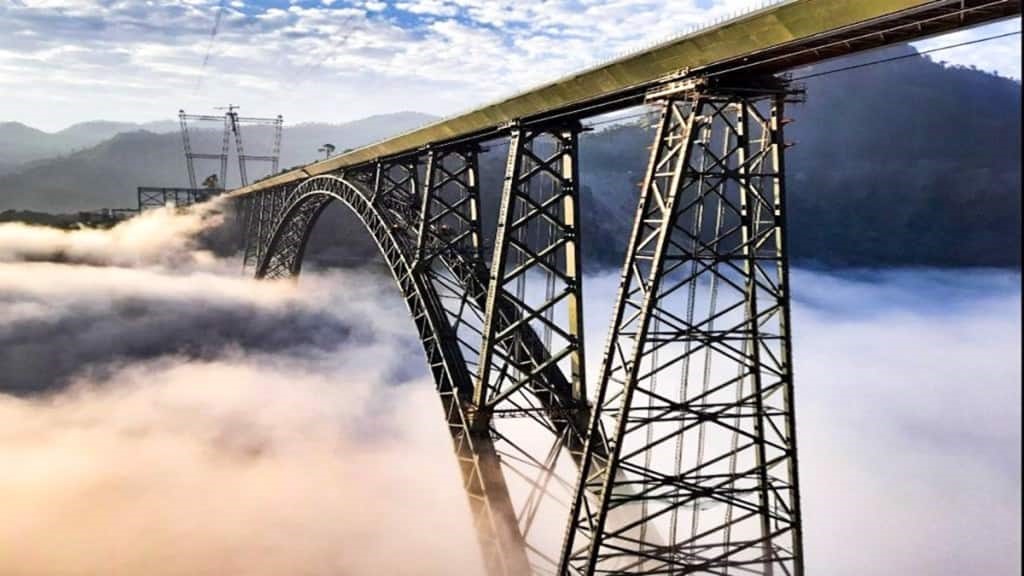Description

Disclaimer: Copyright infringement not intended.
Context
- The Chenab Bridge, located in Jammu and Kashmir's Reasi town, is not just a remarkable engineering feat but is set to become a new tourist attraction in the region.
- This iconic steel arch rail bridge, often dubbed as the world's highest, offers breathtaking views and a unique experience for visitors.
Details
Key Features of the Chenab Bridge
- Height and Location: The Chenab Bridge stands at a staggering height of 359 meters above the riverbed, making it the world's highest steel arch rail bridge. It is situated near Jyotipuram in Reasi town, Jammu and Kashmir.
- Comparison: To put its height into perspective, the bridge soars 35 meters higher than the iconic Eiffel Tower in Paris, France.
- Part of USBRL: The Chenab Bridge is a crucial component of the Udhampur-Srinagar-Baramulla rail link project (USBRL), a massive rail connectivity project in the region covering a stretch of 111 kilometers from Katra to Banihal.
Construction Details
- Materials Used: The construction of the Chenab Bridge involved the use of 28,660 metric tons of steel, 10 lakh cubic meters of earthwork, 66,000 cubic meters of concrete, and the creation of 26 kilometers of motorable roads.
- Innovative Arch Design: The bridge's arch is constructed using steel boxes, and concrete has been filled in these boxes to enhance stability.
- Longevity: Designed for a remarkable 120-year lifespan, the Chenab Bridge is built to withstand high wind speeds of up to 266 kilometers per hour and can endure earthquake forces of the highest intensity zone-V in the country.

Udhampur-Srinagar-Baramulla Rail Link Project (USBRL)
- National Project: USBRL is a national project declared in 2002, and it has been one of the most challenging endeavors undertaken by Indian Railways.
- Tunnels and Bridges: The project includes the construction of 38 tunnels with a combined length of 119 kilometers, with the longest tunnel, T-49, stretching 12.75 kilometers, making it the country's longest transportation tunnel. Additionally, 927 bridges with a combined length of 13 kilometers are a part of this ambitious project.
Reasi District's Attractions
- Shiv Khori: A famous cave shrine that attracts pilgrims and tourists.
- Salal Dam: A hydroelectric project and scenic spot.
- Bhimgarh Fort: An ancient fort with historical significance.
- Mata Vaishno Devi Shrine: Atop Trikuta hills, this revered shrine is a major pilgrimage site in the district.
About Chenab
The Chenab River is one of the major rivers of the Indian subcontinent, flowing through the northern region of India and Pakistan. Originating from the Himalayas, it plays a vital role in the socio-economic and ecological aspects of the region, particularly in the Union Territory of Jammu and Kashmir
Geographical Overview:
- Source: The Chenab River originates from the confluence of two major streams, the Chandra and the Bhaga, near Tandi in Himachal Pradesh, India.
- Course: From its source, the Chenab flows northwest through the mountainous regions of Himachal Pradesh and Jammu and Kashmir.
- Tributaries: It is joined by several tributaries, including the Marusudar, Sohan, and Jhelum rivers.
- Confluence: The Chenab eventually merges with the Sutlej River in Pakistan before joining the Indus River.
Significance:
- Agriculture: It is a lifeline for agriculture in the region, providing water for irrigation and sustenance to farmers in the Chenab Valley.
- Hydropower: The river's fast-flowing waters have been harnessed for hydropower projects, contributing significantly to the power generation capacity of the region.
- Transportation: Historically, the Chenab served as a vital trade route connecting the plains with the mountainous regions, facilitating transportation and trade.
- Ecological Diversity: The river and its adjoining areas are rich in biodiversity, supporting various species of aquatic life, including the Indus dolphin.
Challenges and Conservation:
- Water Disputes: The Chenab River has been a source of water disputes between India and Pakistan. Both countries have entered into various agreements to regulate its use.
- Environmental Concerns: Overexploitation, pollution, and habitat degradation pose threats to the ecological health of the river. Efforts are being made to address these concerns and protect the river's ecosystems.
- Hydropower Development: While hydropower projects have provided energy, they also impact the river's flow and ecology. Balancing development with conservation is a key challenge.
Cultural and Historical Importance:
- Mythology: The Chenab River finds mention in local folklore and myths, contributing to the cultural heritage of the region.
- Historical Sites: Along its banks, one can find numerous historical sites, including ancient temples, forts, and settlements that bear witness to the river's historical importance.
.jpg)
Conclusion
The Chenab River, originating in the pristine Himalayas and flowing through the picturesque landscapes of Jammu and Kashmir, is more than just a water body. It is a lifeline for the people, an engine for economic development, and a source of cultural richness. However, it also faces challenges that require responsible management and conservation efforts to ensure its sustained vitality for generations to come.
MUST READ ARTICLES:
https://www.iasgyan.in/daily-current-affairs/indus-water-treaty-35
|
PRACTICE QUESTION
Q. Which of the following statements about the Chenab River is true?
1. It is the longest river in India.
2. It flows exclusively through the state of Jammu and Kashmir.
3. The Chenab River is known for its delta region.
Options:
a.1 and 3
b.2 and 3
c.2 only
d.None
Answer: d.
|











